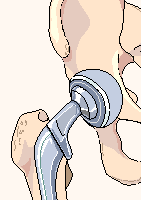|
PT Classroom - Orthopaedic Technology Improves Each Year ׀ by James A. Shapiro, MD |

Dr. James A. Shapiro received his medical degree from Rush Medical College in Chicago and completed his orthopaedic surgery residency at Chicago's Michael Reese Hospital. As a board-certified orthopaedic surgeon, he developed his expertise in sports medicine, serving as Team Physician for the Kenosha Twins and providing coverage for high schools and colleges. He also specializes in hip and knee replacement surgery. |

Joint Replacement Surgery revolutionized the treatment of late-stage arthritis for most patients. Enhanced surgical techniques and modern care during and after the hospital stay help speed recovery and get patients back to near normal function. Design engineers and orthopaedic surgeons hope improvements of implants and materials will allow longer-lasting function of the replacements. These improvements may allow joint replacement in younger patients and provide an alternative to patients who fail to receive adequate relief from conservative treatments. The hip is a good example of a large weight-bearing joint frequently replaced. Composed of two main parts, the hip is referred as a ball and socket joint. The "ball" at the top of the thigh bone fits perfectly into the round "socket" of the pelvis. The shapes of the bones, the muscles, and "ropes" of tissue between the bones, called ligaments, provide stability to the joint. The ball and socket are both covered with a smooth, durable layer of cartilage that cushions the ends of the bones and enables them to move easily and painlessly. It is this layer that wears away in most forms of arthritis. Physicians and researchers continually try to find a way to effectively replace healthy living cartilage, but success is likely many years away.
Varied Designs At this time, the best solution medical science has to offer is to replace the entire joint. Many different designs and materials are currently used in artificial hip joints, but all consist of two basic components- the ball and the socket. Both components are attached to the normal bone with either a rough surface (in which bone will grow) or bone cement. Just as the surface formed by nature can also wear out with time, the "weak link" of hip replacements, according to most studies of joint replacement, is the contact surface between the ball and socket. The surface of the new replacement joint slowly wears away with time and can eventually cause the ball or the socket to loosen from the bone. Even the most polished ball-and-socket surfaces have tiny scratches that can scrape against each other and cause the loss of tiny particles. The body recognizes these particles as foreign, stimulating the formation of special cells to clean up the body. These clean-up cells, however, often dissolve the bone (osteolysis) near the metal pieces of the joint replacement, causing them to loosen and require replacement.
Revision Surgery The second operation, or revision, is much more difficult and has higher risks of complications and lower rates of patient satisfaction. The severity of the osteolysis depends upon the amount of wear debris the joint and its bearing surface produce. The amount of wear debris is linked to several factors, including the forces across the joint, the amount of its use, and the materials used to make the joint surface. The force across the artificial joint depends on the patient's weight and his level of activity, such as jogging versus walking. The joint's amount of use is easily measured by the number of steps the patient takes and by the patient's longevity after the joint-replacement surgery. For those reasons, most orthopaedic surgeons discourage joint replacement in overweight, active patients who are young. The materials comprising the weight-bearing surface of the joint plays a large role in the amount of wear debris.
The first joint replacements used metal balls on Teflon but were abandoned because of a high amount of wear debris. Ultrahigh molecular weight polyethylene, a strong white plastic, is used most frequently and has the longest track record. More than 90% of metal-on-polyethylene joints last 10 years or more, however, some do fail earlier. Patients have more than 15 to 20 years of life expectancy run a greater risk of difficult revisions. There are, however, newer materials available expected to reduce wear debris and prolong the life of hip replacements. Advances in public health and medicine have created a healthier baby boom generation. The increased life expectancy and desire for a more active lifestyle also place greater demand on the technology of joint replacements.
Minimizing Bone Loss Recent advances in joint replacement are focused on minimizing wear debris. New surface materials include advance cross-linked polyethylene, ceramic heads and cups, and metal-on-metal bearing surfaces. At this time, ceramic surfaces have the lowest amount of measurable wear and extremely popular in Europe, but the brittle nature of ceramics raised concern in the United States. Though the fracture rate of ceramic heads is very low, it is a significant problem requiring a revision operation to correct. Metal-on-metal bearings are now in common use because of low wear rates. Increased metal ions in blood and urine from patients with metal bearings raise concern but have not shown any measurable clinical problems. Newer plastics known as highly cross-linked polyethylenes show improvements in laboratory testing compared to the old standard plastic. This innovative plastic is processed with radiation to form bonds between the long chains of molecules in the plastic. At least three different companies have three different highly cross-linked plastics on the market. Usually, the plastic bearing surfaces are the least costly of the bearing-surface options. Deciding on which bearing surface to use is controversial. There is no consensus within the scientific or orthopaedic communities. With any new technology in joint replacement, it takes approximately 10 to 15 years to demonstrate any measurable improvement. Clinical research is the only way to measure the results from the choices available to the surgeon.
After Surgery Joint replacement surgery can relieve pain and help patients return to most of their normal, everyday activities. The vast majority of individuals who undergo hip replacement surgery experience dramatic reduction of hip pain and significant improvement in their abilities to perform the common activities of daily living. However, hip replacement surgery will not enable a patient to do more than he or she could do before the hip problem developed. Following surgery, however, the patients should avoid certain activities for the rest of their lives, including jogging and high-impact sports. If you are considering a hip replacement surgery, please talk to your physician about your expectations and his or her expectations of results from the procedure. To learn more and see animated videos on joint replacement and other hip/knee surgeries click here: Hip & Knee ViewMedica Orthopedic Animations
Last revised: December 3, 2008 |
|
|
|
|






